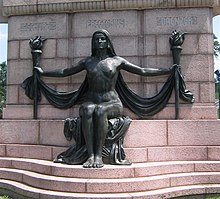Compton Hill Reservoir Park
| Compton Hill Reservoir Park | |
|---|---|
 Compton Hill Water Tower, one of only seven surviving standpipe water towers in the United States, is a national historic landmark. | |
 | |
| Type | Municipal |
| Location | St. Louis, Missouri |
| Coordinates | 38°36′53″N 90°14′15″W / 38.61472°N 90.23750°W |
| Area | 35.8 acres (14.5 ha) |
| Created | 1867 |
| Operated by | City of St. Louis |
| Open | All year |
| Public transit access | |
Compton Hill Water Tower | |
| Location | St. Louis, Missouri |
| Coordinates | 38°36′54″N 90°14′20″W / 38.61500°N 90.23897°W |
| Built | 1898 |
| Architect | Harvey Ellis |
| Architectural style | French Romanesque |
| NRHP reference No. | 72001555 |
| Added to NRHP | September 29, 1972 |
Compton Hill Reservoir Park is a 36-acre (15 ha) public park located in the Compton Heights neighborhood of St. Louis, Missouri, USA. Located on one of the highest elevations within the city, the park surrounds a 28-million-US-gallon (110,000 m3) reservoir used to provide water for many of the city's residents.[1]
History
[edit]James P. Kirkwood selected the site of the reservoir, one of the highest elevations within the 1855 city limits.[2] As the reservoir occupied only 18 acres (7.3 ha) of the site, Kirkwood suggested the remaining land be turned into a park.[1] The top of the reservoir structure was at one time covered with elevated tennis courts; presently, two newer tennis courts lie to the east.
The water tower was retired in 1929, after 30 years, when the Howard Bend Plant was put in service: the static head from the Stacy Park Reservoir, in what is now the St. Louis suburb of Olivette, caused an overflow of pure chemically treated water into the sewer system.[3] The reservoir and water tower were renovated, in 1999, at a cost of $19 million.[1]
In 1969, Interstate 44 was constructed through the northern edge of the park, reducing the area of the park to its present size.[1]
Compton Hill Water Tower
[edit]
The Compton Hill Water Tower, built in 1898, is the youngest of three remaining stand pipe-water towers in St. Louis. Whereas, in 1901, more than 423 stand pipe style water towers existed in the United States,[4] as of 2008 only about a dozen remain standing, three of which are in St. Louis (the other two being the Bissell Tower and the Grand Avenue Water Tower).[3] The 179-foot (55 m) tower was built to disguise a 6-foot (1.8 m) diameter, 130-foot (40 m) tall standpipe in its interior.[3] The standpipe helped to control the dangerous surges in the city's pipes caused by the reciprocating pumps and maintain an even water pressure.[3] The water tower was designed by Harvey Ellis who also had a hand in designing the headhouse for St. Louis Union Station.[3] Occasionally, the observation deck at the top of the water tower is opened to the public, allowing visitors to see 360-degree panoramic views of the city.[5] The Compton Hill Water Tower was declared a city landmark in 1966 and added to the National Register of Historic Places in 1972.[1]
The Naked Truth
[edit]
The statue The Naked Truth, unveiled in 1914, was a gift to the city of St. Louis by the German-American Alliance in honor of Carl Schurz, Emil Preetorius and Carl Daenzer, editors of the German St. Louis newspaper Westliche Post.[1] Controversy erupted over the statue's nudity before the monument was even built when a jury selected the design of Wilhelm Wandschneider, the only non-local sculptor in the design contest.[6] At the request of Adolphus Busch, who had contributed $20,000 of the $31,000 cost of the monument, the statue was made of bronze instead of white marble to deemphasize the nudity.[1]
The statue was moved to its present location south of the water tower after Interstate 44 was constructed through the northern edge of the park.[6] The statue was designated a city landmark in 1969.[1]
See also
[edit]- Chicago Water Tower
- Louisville Water Tower
- Tower Grove East, St. Louis, nearby neighborhood that had a large German American population by the 1850s
- Tower Grove Park, the park located a short distance south on Grand Boulevard
References
[edit]- ^ a b c d e f g h "Compton Hill Reservoir Park". City of St. Louis. Retrieved 2008-05-21.
- ^ Schworm, William B. "A History of the St. Louis Water Works". City of St. Louis Water Division. Archived from the original on 2008-08-28. Retrieved 2008-06-17.
- ^ a b c d e "National Register of Historic Places: Inventory - Nomination Form" (PDF). Missouri Department of Natural Resources. 1972-09-29. Retrieved 2008-05-30.
- ^ Hazelhurst, James Nisbit (1904). Towers and Tanks for Water Works (2nd ed. revised and enlarged ed.). New York: John Wiley & Sons. p. 9. OCLC 3704531. Retrieved 2008-06-16.
- ^ "Tower Openings". The Water Tower and Park Preservation Society. Archived from the original on 2008-06-13. Retrieved 2008-06-16.
- ^ a b "St. Louis Historic Preservation: Statue of the Naked Truth". City of St. Louis. Retrieved 2008-05-30.
External links
[edit]- Compton Hill Reservoir Park official site
- [1] Facebook page
- Compton Hill Water Tower - Compton Heights neighborhood page about the water tower
- The Water Tower and Park Preservation Society
- Built St. Louis: the Water Towers - Information about the three remaining water towers in St. Louis
- Parks in St. Louis
- Urban public parks
- Water supply infrastructure on the National Register of Historic Places
- Landmarks of St. Louis
- German-American culture in St. Louis
- National Register of Historic Places in St. Louis
- Industrial buildings and structures on the National Register of Historic Places in Missouri
- Tourist attractions in St. Louis
- 1867 establishments in Missouri
